| From: GLCarlley
|
|
|
|
|
|
|
| Date: 10-Oct-20 |
|
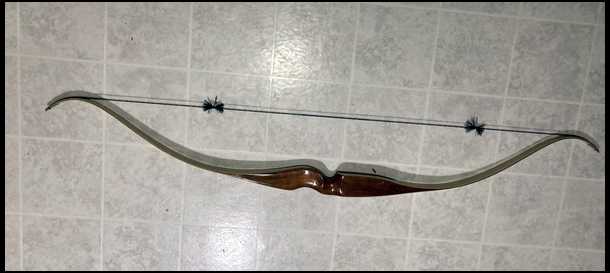
I picked this up recently and It’s a super smooth bow, but I’ve had a heck of a time finding any history on this one. From looking at the catalog it’s most certainly a Browning and likely a Trophy model. I can not find hardly any photo’s or info on these bows. I suspect this was a very early in production bow. Anyone a Browning/Gordon expert?
|
|
| From: GLCarlley
|
|
|
|
|
|
|
| Date: 10-Oct-20 |
|
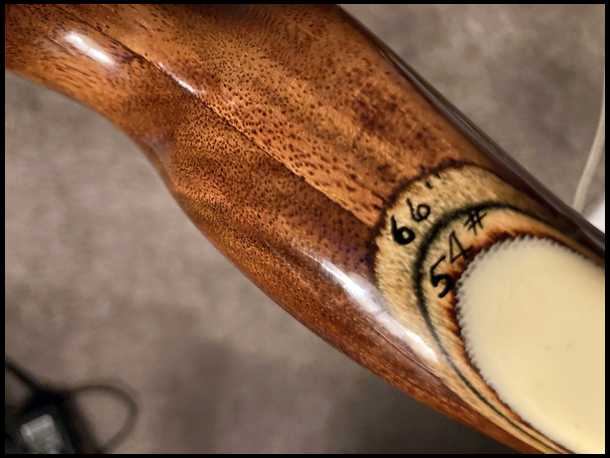
This is the only marking on the bow, nothing else anywhere.
|
|
|
|
| From: mangonboat
|
|
|
|
|
|
|
| Date: 11-Oct-20 |
|
Almost certainly a 1961 or early 62 Gordon Royal Queen or Custom that is identical to a Trophy but with a walnut riser. Even the earliest Browning bows Gordon made were marked in gold lettering on the lower end of the riser, while all bows sold as Gordon's had the weight and length written over the ends of the lower limb core. The white glass and tip overlays suggest a Gordon Custom. Is the month and year stamped into the lower riser over the fade? If not, it could be a one-off, one of many Jack Bice and Jerry Amster came up with in 1961 while putting together Browning's initial line up. Either way, a gorgeous bow and I bet its a sweet shooter.
|
|
| From: Blackhawk
|
|
|
|
|
|
|
| Date: 11-Oct-20 |
|
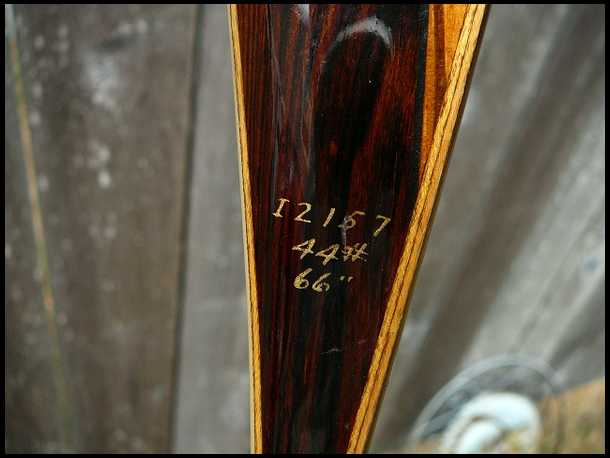
Here's an early Browning Apollo that some of the "experts" believe was a first year Browning and shows the type marking mentioned above.
|
|
| From: GLCarlley
|
|
|
|
|
|
|
| Date: 11-Oct-20 |
|
The only markings are the length and weight on the bottom of the grip. It’s a perfect match for the Browning Trophy, if you look in the 62/63 Catalog, it’s absolutely a perfect match match but once again, nothing else is stamped anywhere on it and I’ve never seen any bow have the weight and length where this one do(under the grip on the back side).
|
|
| From: GLCarlley
|
|
|
|
|
|
|
| Date: 11-Oct-20 |
|
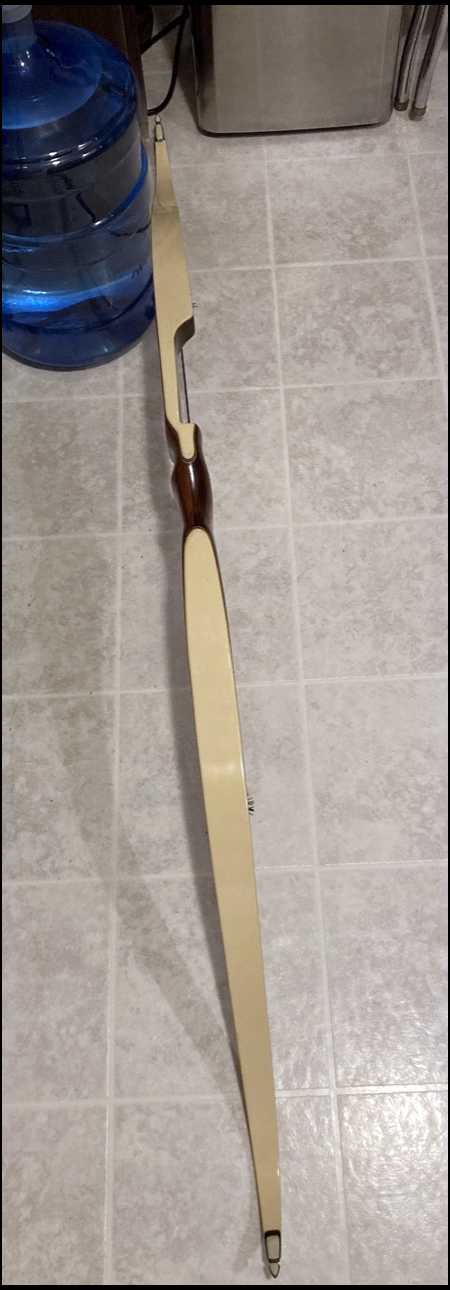
This is the front of the bow.
|
|
| From: GLCarlley
|
|
|
|
|
|
|
| Date: 11-Oct-20 |
|
This is the front of the bow.
|
|
| From: GLCarlley
|
|
|
|
|
|
|
| Date: 11-Oct-20 |
|
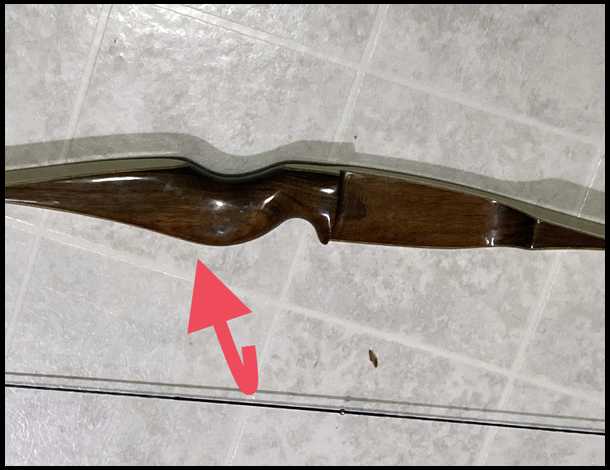
This is where the weight and length are written.
|
|
| From: brianbfree
|
|
|
|
|
|
|
| Date: 11-Oct-20 |
|
Funny you read about how much Drake had to do with that company but when you shoot on of his bows or compare one next to a Browning it really hits you . Browning never made a bad bow and the materials were top of the line.
|
|
| From: GLCarlley
|
|
|
|
|
|
|
| Date: 11-Oct-20 |
|
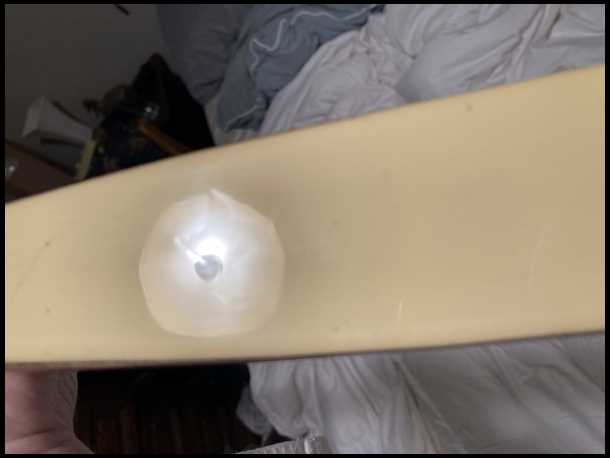
So I spotted this going over the thing with a flashlight this morning. It’s had a Browning logo scrubbed from it. Nothing about the bow suggests it’s been refinished but there is a spot where a Browning decal should be/would have been. Very off bow. I’m not much of one for white glass but it’s a hell of a nice bow for the range, where it fits in very well. It’s to long and “bright for hunting(at least for me it is) but that length is great on the bow range, very smooth, no stacking at all. All that said if this thing had carmel or brown glass, I get over the crazy lengrh pretty quick and take it huntig.
|
|
| From: Kelly
|
|
|
|
|
|
|
| Date: 11-Oct-20 |
|
Spray paint will take care of that white glass if you think it's a deterrent.
|
|
| From: Steve P
|
|
|
|
|
|
|
| Date: 11-Oct-20 |
|
Paint or limb covers or...those limbsations. I have a white glass Hoyt I've hunted with and hasn't seemed to be a detriment. Late season and snow it blends right in. I used to think short bows were what was needed hunting until I got my first longbow which was 68". Found that long length wasn't much of a problem at all, though I haven't use a pop-up and rarely hunt from trees any longer. All this to say that if you like the bow and it shoots nice for you, don't rule out hunting for length or color. It is one beautiful bow, enjoy it.
Steve
|
|
| From: mangonboat
|
|
|
|
|
|
|
| Date: 11-Oct-20 |
|
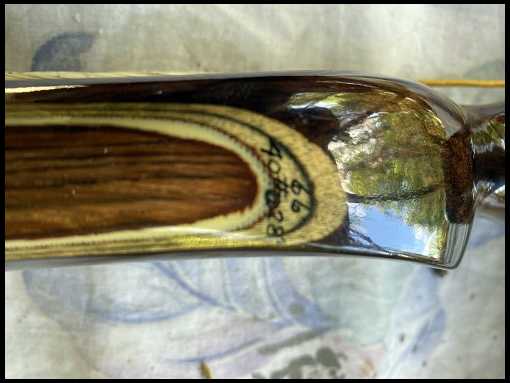
Almost certainly that spot on the limb is where a Clan Gordon decal peeled off.. they were notorious for that. If it was marketed as a Browning, it would have the specs written in gold on the lower riser. ALL Gordon bows had the weight and length written where it is on your bow. Also, Browning spec was Indian rosewood riser for the Trophy and your bow is not Indian rosewood. Browning was clear that they would sell no bow that didn't meet their specifications as a Browning bow, not even a Browning-labeled 'second'. For 14 years, long after the Gordon source was severed, Browning sold 'seconds' as "Deluxe Composite Bow" and wrote the specs on the old Gordon location . By the way, Harry Drake had NOTHING to do with Browning recurves until the folding and take down Backpacker and Firedrake models of the early-mid 1970's. All the early Browning bows were designed and built under the supervision of Jack Bice, who had been bow production supervisor at Gordon Plastics. The photo is the Gordon specs written on an early 1962 Clan Gordon Royal Monarch, almost identical to the Browning Olympian, that Jim Baker has now .
|
|
| From: mangonboat
|
|
|
|
|
|
|
| Date: 11-Oct-20 |
|
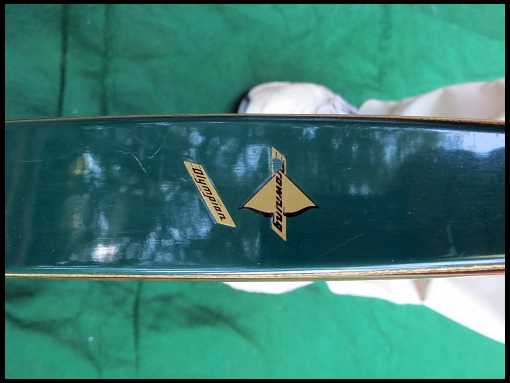
There would be two Browning labels..my 1962 Olympian .
|
|
| From: mangonboat
|
|
|
|
|
|
|
| Date: 11-Oct-20 |
|
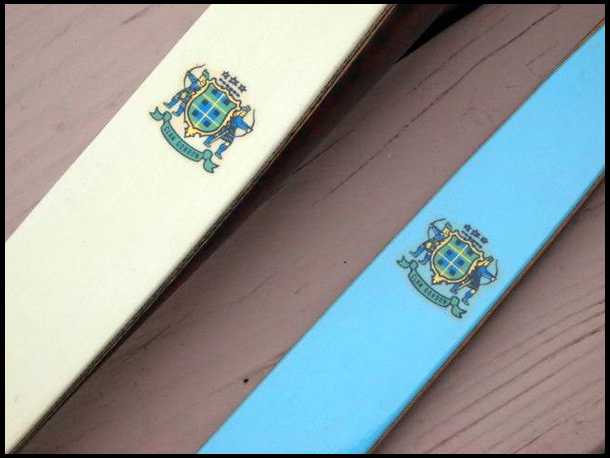
One shield -shaped Clan Gordon decal. 1961 Royal Monarch and Royal Queen..
|
|
| From: Pdiddly
|
|
|
|
|
|
|
| Date: 11-Oct-20 |
|
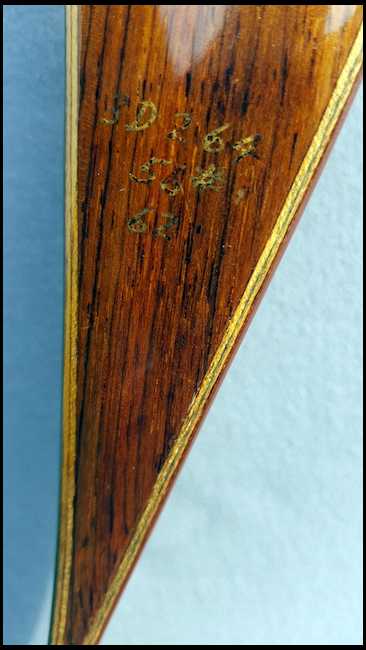
mangonboat is 100% correct in his analysis...
That is certainly a Gordon. Great bow!
Here's the specs on a very early (1963) Browning Explorer done in typical Browning fashion.
brianbfree...Harry Drake did not get involved with Browning until 1974, as Mark said. It's an oft repeated myth that he was involved in the initial design in 1961, and one that has grown legs.
|
|
| From: Pdiddly
|
|
|
|
|
|
|
| Date: 11-Oct-20 |
|
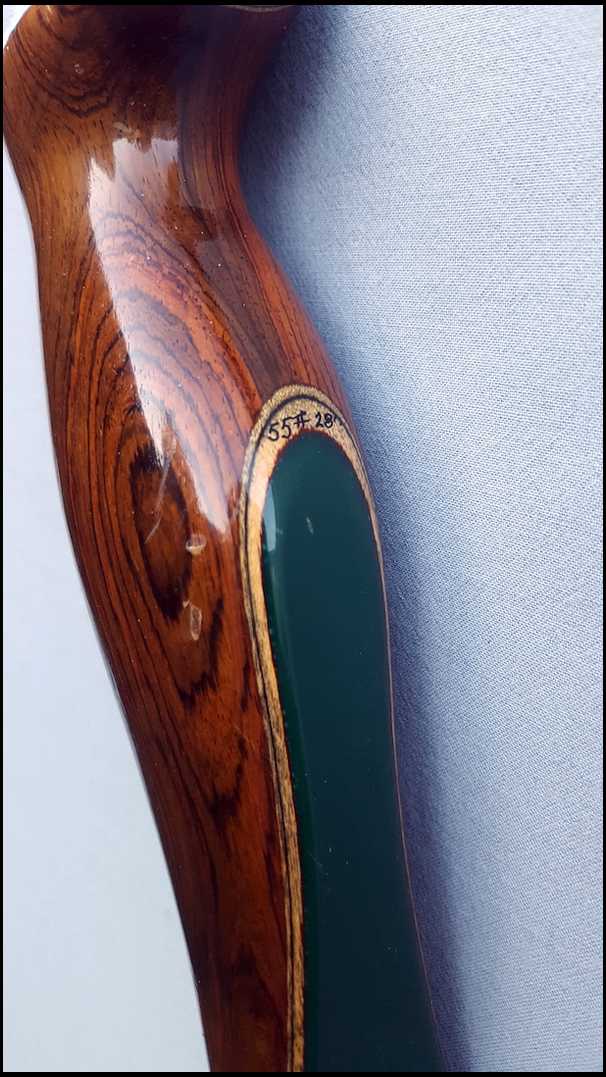
Here's the specs on a Gordon Royal Huntsman from 1961.
Just like your bow...
The other thing you can see is the dark layer between the two limb laminations on your bow, mine and Mark's. That is Gordon Bo-Kore, a pre-made wooden lamination with a black fibreglass scrim layer.
|
|
| From: jaz5833
|
|
|
|
|
|
|
| Date: 12-Oct-20 |
|
Harry Drake had nothing to do with these bows.
|
|
| From: crookedstix
|
|
|
|
|
|
|
| Date: 12-Oct-20 |
|
Yes, it's important to give Gordon their props. It's not as if they are a separate entity; literally ALL early Brownings were just Gordon bows dressed up with a Browning decal.
|
|
| From: GLCarlley
|
|
|
|
|
|
|
| Date: 12-Oct-20 |
|
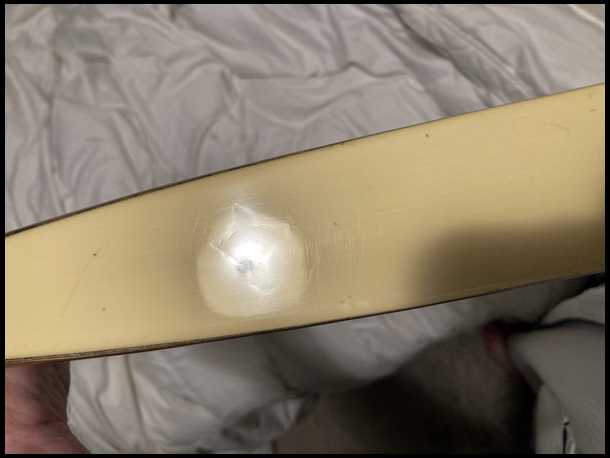
Next question. If it is a Gordon why is there a perfect outline of a Browning decal?
|
|
| From: Kelly
|
|
|
|
|
|
|
| Date: 12-Oct-20 |
|
If this was a Gordon, or even an early Browning would it have the tip overlays of glass like this one has and all of the after 1964 Brownings have? The early Brownings I’ve had including Apollo, Medallion, Safari II didn’t have tip overlays. Rather they had tip wedges inserted between the lams.
|
|
| From: Kodiak
|
|
|
|
|
|
|
| Date: 12-Oct-20 |
|
It's looks like a really well made bow. Very nice.
|
|
| From: Pdiddly
|
|
|
|
|
|
|
| Date: 12-Oct-20 |
|
Kelly...Safari never had tip wedges...had glass overlays.The Nomad had tip wedges.
Same with the 1963 Explorer I posted the specs on above...overlays but no wedges.
The OP is convinced his bow is a Browning but the evidence indicates it is clearly a Gordon.
|
|
| From: mangonboat
|
|
|
|
|
|
|
| Date: 12-Oct-20 |
|
I dont think it makes much difference to which brand we attribute that bow to if it was made in the same shop, either way, and is probably a great shooter no matter what you call it. One explanation for the shadow of a Browning decal on the limb but no model decal below it is that, after the Browning decal was applied it was pulled at final inspection before the specs and serial number were written on the side and instead the silk screen Browning decal was removed with a wet sponge, the specs were written in the Gordon / Deluxe Composite Bow location and the final top coat of finish applied. The Clan Gordon bows all got stamped serial numbers into the lower riser in the fade, but Geoff's bow doesn't have that. The Deluxe Composite Bows all started out to be Browning's, not Gordon's , and I've never seen one with a serial number. The DCB decal was a sticky-backed paper decal applied to the lower limb after the top coat of finish. Here's a link to a recent ebay listing for a early 1970's Browning nomad Stalker that was spec'd then labeled and originally sold as a Deluxe Composite Bow. https://www.ebay.com/itm/Re-Curve-Bow-old-034- deluxe-composite-bow-034-52-034-48-no-other-markings- found-/174427729235.
|
|
| From: GLCarlley
|
|
|
|
|
|
|
| Date: 12-Oct-20 |
|
Interesting. My only indication it may have been a Browning was the distinct outline of the logo, but once again, I have no idea whatsoever. Bow shoots very smoothly. I do wish it was a 45# bow but it does good.
|
|
| From: ronnickel
|
|
|
|
|
|
|
| Date: 12-Oct-20 |
|
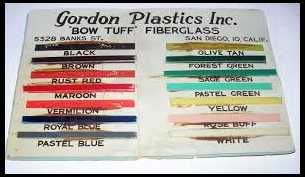
Here's info I collected when I obtained a Gordon bow -
Gordon Plastics
George, Don & Dave Gordon entered into a business partnership in 1953s producing fiberglass panels for commercial buildings, and fiberglass diving boards in southern California. In the mid-1950s, a San Diego bowyer named Frank Eicholtz approached them about making a better facing and backing for his laminated bows. After discussions that piqued the Gordons’ interest, the brothers started making a fiber reinforced laminate for the facing and backing for recurve bows. Early products sandwiched a wood core between layers of fiberglass-reinforced plastic.
The Gordon brothers were lifelong hunting and fishing enthusiasts, which helped motivate them to design and build their first line of bows: "Gordon Royal Bows." They named their laminated "Standard B0-Tuff". The laminate worked well on recurves and their bow market took off. Their bows performed so well with their fiberglass limbs that bow makers started purchasing Gordon laminates for their lines.
In 1958-59, the Gordon Plastics “Royal Line” of bows included five models: • The King $59.50 67” length weight: 30 to 55 pounds • The Knight $54.50 62” length weight: 30 to 70 pounds • The Prince $54.50 67” length weight: 30 to 60 pounds • The Queen $44.50 64” length weight: 25 to 55 pounds • The Page $32.50 62” length weight: 20 to 55 pounds
In 1961-62, they added to more models to the line and changed the names of some models: • The Royal Monarch $89.50 66” or 69” length weight: 30 to 60 pounds • The Royal King $74.50 66” or 68” length weight: 30 to 60 pounds • The Royal Knight $54.50 62” length weight: 30 to 70 pounds • The Royal Queen $44.50 64” length weight: 20 to 40 pounds • The Royal Huntsman $49.50 54” length weight: 30 to 70 pounds • The Duke $39.50 64” length weight: 30 to 60 pounds • The Page $32.50 62” length weight: 20 to 55 pounds • The Jester“ $22.50 60” length weight: 15 to 40 pounds • The Squire $14.95 48” length
In 1961 the three brothers also developed and manufactured the "Glashaft and Graflex" fiberglass arrow shafts, which they enjoyed field testing along with their latest designs in bows.
In 1964 the three brothers were approached by Browning Arms to produce a line of hunting bows under the Browning name, which they agreed to do. Shortly after this time, they discontinued their own line of bows and produced bows only for Browning Arms, Co. In 1973 Browning purchased the bow manufacturing operation outright.
Gordons then refocused on producing Bo-tuff laminate for general use within the archery industry. Root, Bear, Wing, and Ben Pearson were just some of the companies that used Gordon laminate for their limbs. Today, Gordon Composites still produces fiberglass laminate, and solid glass billet material for the majority of bows manufactured worldwide
|
|
| From: GLCarlley
|
|
|
|
|
|
|
| Date: 27-Oct-20 |
|
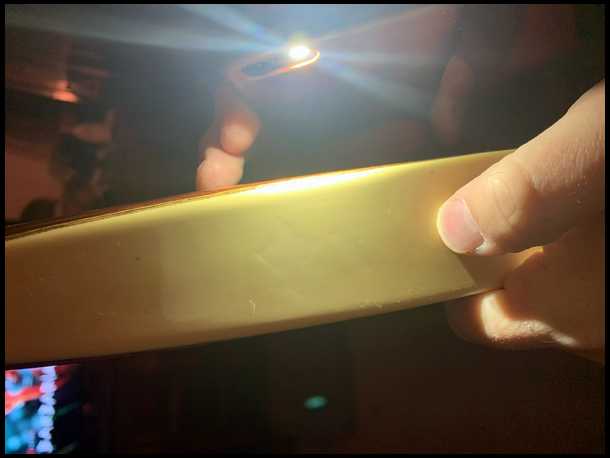
I found a better photo of where someone has scrubbed what is most certainly a Browning logo off. Well I didn’t find it, I held a light while someone else photographed.
|
|
| From: GLCarlley
|
|
|
|
|
|
|
| Date: 27-Oct-20 |
|

This is a logo I found on google. But it’s a dead ringer. Which makes the location of the weight and length and lack of a serial number very strange
|
|
| From: GLCarlley
|
|
|
|
|
|
|
| Date: 27-Oct-20 |
|
It’s like someone went to clean it and used acetone or something harsher than 91% alcohol and maybe that’s even to harsh. I’d really love to find someone who was around Browning in 62, but at this point that guy would be 80-90 years old, so, unlikely at best being maybe a handful of people hard an extensive knowledge of what was going on with design around there at that point. I’ve got some theories most being that it belonged to someone who for whatever reason did not want a logo on their pretty white fiberglass laminated recurve that happens to shoot very very fast for a 54# bow that doesn’t stack even when drawn on back... it’s just the smoothest bow I’ve handled. I do wish very much it was a 40-47# bow but I’m getting use to it. My 41 and 43# Pearson bows are smooth but nowhere near as smooth as this thing, it’s just a hair to heavy for me but It gets better daily.
|
|
| From: Kelly
|
|
|
|
|
|
|
| Date: 28-Oct-20 |
|
Pdiddly, I did have a Safari II that had tip wedges, no glass overlays. Exactly the same as the Apollo and Medallions I’ve had. Unfortunately I sold that Safari II to a lady in Texas who has since sold it again. That said, I’ve not seen another one since-yes I’ve been looking because regret selling it. It was one on the finest shooting bow I’ve ever owned, right up there with my Red Wing Hunters.
|
|
| From: GLCarlley
|
|
|
|
|
|
|
| Date: 28-Oct-20 |
|
Pretty certain it’s a Trophy model. Yeah, I’ve got over the glass being white. I’d rather it was a 45-48#’er with carmel glass, but it’s the bow I picked out and purchased which is white and 54#. It is beautiful and I do enjoy it. Unfortunately the bow I’ve got that I like more than all my others or any bow I’ve handled is in the worst shape or any bow I’ve got. 68 or there about Pearson Cougar with a bent lower limb. I found a man i think I’m going to send her to qnd Ave it straightened out. He does a little basic refinish as well all for like $119 so that’ll be just awesome to get done. When it’s done I’ll probably turn around and give it to a good buddy of mine who wants to try traditional archery... go figure.
|
|
| From: jaz5833
|
|
|
|
|
|
|
| Date: 21-Jan-21 |
|
This bow was almost certainly made in the Gordon Plastics location on Banks Street in San Diego and labeled as a Browning. Then, for some reason that will likely never be know, the Browning label was removed.
A likely scenario could be that in the days just after the sale, when Gordon Plastics was to begin making bows for Browning until they could for themselves, they got it wrong. Browning said, "fix it", and it might have been easier to remove the label than the ink marks on the light colored wood and then sold unmarked other than weight and length.
Also, Browning purchased the bow facilities of GPI in very early 62 not 64. Additionally, it's unlikely Frank Eicholtz approached the Gordon's for fiberglass as he was a fierce competitor in this area. They did however, collaborate together with Bud Leach to produce the Gelco line of bows.
|
|
| From: Pdiddly
|
|
|
|
|
|
|
| Date: 21-Jan-21 |
|
Jim: That sounds like a plausible explanation- a bow being built in the middle of the transition from Gordon to Browning that did not reflect the design Browning wished for, in a time that preceded the " Deluxe Composite Bow" decals.
Strong support for that scenario is Blackhawk's bow. It was built very late in 1961 as inventory that would be sold in 1962. It is only the 157th Apollo built but the specs were already being written on the riser. So the OP's bow that had a Browning decal, but had the specs on the heel on the belly of the riser like a Gordon, was an early second, but in appearance only.
I am also glad you corrected the date Browning began marketing and making bows to early 1962!
Kelly: Just saw your post on your Safari with tip wedges...now that would be an interesting bow to find, especially when it is on par with Red Wing Hunters! High praise indeed!
|
|
| From: Great Falls
|
|
|
|
|
|
|
| Date: 21-Jan-21 |
|
Nice thread, very informative, really appreciate the Browning / Gordon history
|
|
| From: mangonboat
|
|
|
|
|
|
|
| Date: 30-Apr-22 |
|
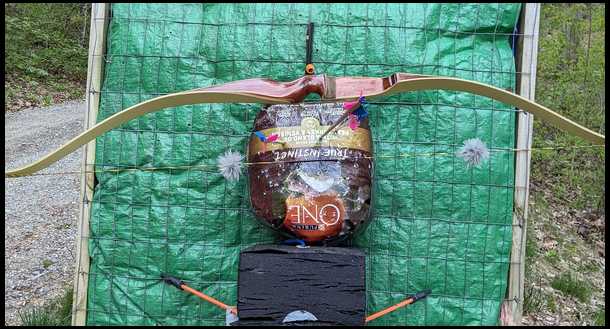
To follow-up and 'close the loop' on this thread , I ended up acquiring the bow in question in a trade with Geoff. Almost every time I shot the bow I would try to find the place where Geoff described and attached pics of a place on the limb where the Browning decal had been, but couldn't find it..until yesterday. I couldn't find it because I was looking for it where the decal SHOULD have been: on the belly side of the lower limb, just below the lower riser fade. But it was a sunny afternoon yesterday and something caught my eye on the BACK side of the lower limb. Sure enough, there was the distinct outline of a Browning decal AND the distinct diagonal stripe from the second decal, the model name, both covered over with a coat of clear finish that was applied at the factory and yellowed a bit over time along with the rest of the clear finish.
Somebody clearly put the decal on the wrong side of the lower limb, it was removed but somebody in the finish room accurately assessed that the adhesive from the decals would leave a mark on the limb, so the bow was pulled and the specs written over the upper edge of the belly side limb laminations, where, previously, the specs were written on Clan Gordon bows and, in the Browning era, on 'seconds'. Mystery solved!
I think Geoff's initial conclusion was correct, that this bow was built as a Browning Trophy, because it doesn't have tip wedges like the same-shaped Olympian and also has no Brazilian rosewood riser overlays or tip overlays. A lingering question is the riser wood, as the Browning catalog description of the Trophy, offered only in the first 2 catalogs, indicates East Indian rosewood, but this bow is 59 years old and still has warm lightish brown wood with grain and pores that are NOT a dalbergia species. I'm almost certain it is Northern California 'claro' walnut, and it strongly resembles the walnut in my 1962 Browning Apollo.
The bow is a lot of fun to shoot as it is a perfectly balanced 54# target bow. I hope to hunt with it this fall. The photo is my first group of three shots yesterday, from 45 yards, trying to hit the small upside-down turkey symbol.
|
|
If you have already registered, please sign in now
For new registrations Click Here
|
|
|
|



